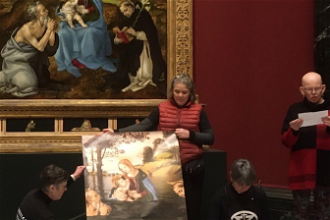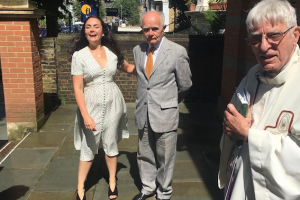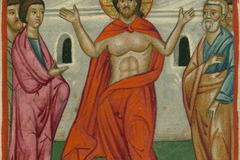Acts of Mercy at the National Gallery

Acts of Mercy - Cayley Robinson image from Wellcome Library
Frederick Cayley Robinson (1862-1927) is one of the most distinctive yet elusive British painters of the early 20th century. A new show just opened at the National Gallery is the first exhibition of his work in the United Kingdom for over 30 years.
The title 'Acts of Mercy' derives from the several Corporal Works (or Acts) of Mercy which are the main principles underlying the historical development of hospitals. These seven Acts are: feeding the hungry, giving drink to the thirsty, clothing the naked, giving shelter to the homeless, visiting the imprisoned, attending the sick and burying the dead. Six of these receive their authority from the words of Jesus Christ in a parable in the Gospel of Matthew 25:35-40.
With the addition of the burial of the dead from the book of Tobit, these words were systemised by St Cyprian, St Ambrose and St Thomas Aquinas. There after they became the standard rationale for charitable institutions, updated for modern times and depicted in mural paintings. In continuing this ancient tradition into the 20th century, Cayley Robinson brought his own contributions to the theme.
The four central paintings at the National Gallery the summation of Cayley Robinson's artistic ambition. Executed between 1916 and 1920, his masterpiece, Acts of Mercy, comprises four large-scale allegorical works commissioned to adorn the new Middlesex Hospital, rebuilt 1928-1935.
Along side Cayley Robinson's modern works, National Gallery paintings by Piero della Francesca (The Baptism of Christ, 1450s), Sandro Botticelli (Four Scenes from the Early Life of Saint Zenobius, about 1500) and Pierre-Cécile Puvis de Chavannes (Summer, before 1873) are being shown.
Acts of Mercy rank as the most important decorative commissions of the early part of the 20th century, but they are also among the most singular works in modern British art. Their underlying message concerns the sanctity of human altruism expressed through medical healing and the care of orphaned children.
Cayley Robinson's pictures are almost always of people; denizens of a silent, timeless world. A frequent theme is the care for the young and the old. Essentially a British Symbolist, Robinson created a striking variety of moods and atmosphere in his paintings to evoke complex emotional responses. His work characteristically incorporates a rich variety of altruism and symbolism, but often meaning is reserved, or implicit, creating an aura of mystery or ambiguity. There are symbolic allusions but no clear cut messages.
The exhibition celebrates a British heritage success and provides a timely opportunity to re-examine a little known yet highly distinctive artist who now seems to stand outside the main developments of British art. Taking the form of a modern allegory or history painting, Acts of Mercy memorably explores the positive forces of the human spirit in the face of destruction.
Frederick Cayley Robinson: Acts of Mercy is a National Gallery exhibition created in collaboration with Tate Britain.
The show, supported by the Wellcome Trust, is in the Sunley Room from 14 July - 17 October 2010. Admission free





















